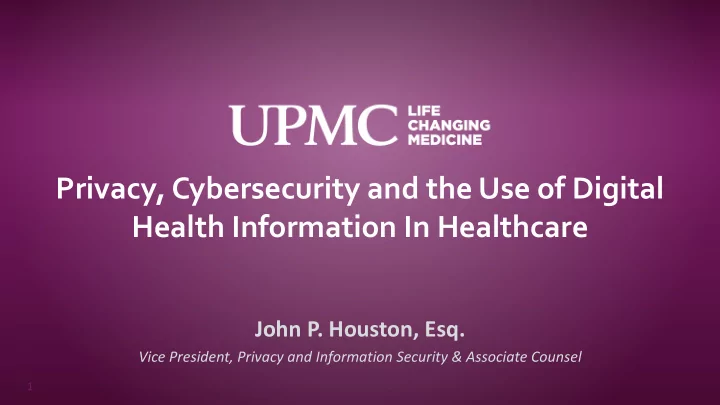

Privacy, Cybersecurity and the Use of Digital Health Information In Healthcare John P. Houston, Esq. Vice President, Privacy and Information Security & Associate Counsel 1
Types of Digital Health Information UPMC has been progressive in its adoption and use of electronic heath information technologies and has amassed a significant amount of digital health information, including: • Structured text information • Unstructured text information • Image and audio information • Test results • Genetic Information 2
Types of Digital Health Information Identifiable Health Information • Available for Treatment, Payment, Healthcare Operations (without patient consent) Exceptions for research • Facially De-identified Health Information Available for research and quality assurance purposes • Requires execution of a Data Use Agreement • De-identified Health Information Available for any purpose • 3
Digital Health Information Uses • Treatment • Payment • Healthcare Operations 4
Digital Health Information Uses Digital health information has become increasingly used for a variety of secondary purposes, including: • Research • Clinical trials • Quality assurance • Education • Accreditation • Innovation 5
How It Fits Together 6
Digital Health Information 7
The One Constant is Change Security is not a static discipline • Technologies change • Uses change • Threats change • Security Solutions change 8
Technology Changes Affecting Cyber-Security • The “move to the cloud” (SaaS, PaaS, IaaS, ISaaS, etc) • Mobile device capabilities • Big data • Containers • IoT • Data lakes 9
Use Changes Affecting Cyber-Security • Cloud delivered services • Mobile Device utilization • Consumer engagement • Big data / nano data • The explosion of data 10
Threat Changes Affecting Cyber-Security Increasing threat sophistication / complexity • Malware / Ransomware • DDoS Attacks • Phishing • Nation-state campaigns • Advanced Persistent Threats 11
Security Solutions Affecting Cyber-Security • SIEM / Analytics • CASB • Enhanced endpoint protection • Identity Management • Sandboxing • Improved IDS / IPS tools • Improved user authentication 12
The Changing Data Processing Landscape Y2K • 95% of all applications were run “ on-prem ” – 95% of all newly acquired applications run “ on-prem ” – Little data or “ workload ” was in the cloud – Today • 75% of all applications run “ on-prem ” – Less than 20% of newly acquired applications run “ on-prem ” – In some form 75% of data is in the cloud – 2022 • At most 25% of all applications will run “ on-prem ” – Less than 10% of newly acquired applications will run “on-prem ”. Of those, most – will be utility in nature In some form almost 100% of data will be in the cloud – 13
What is Driving the Move to the Cloud • Delivery of services that have a “cloud-dependency” (such as collaboration) • Efficiency (Maybe) • Claims of reduced cost • Vendor revenue 14
The Good… • Improved collaboration • Increased agility • Reduced IT “footprint”, allowing IT to focus on “value added IT” • Predictable operating expense • Improved security (in some cases) 15
The Bad… • Decreased data integration • Reduced IT capability • Additional overall expense to the organization • Less security (in some cases) 16
The Ugly… • Islands of data • Shadow IT • Unquantified expense to the organization • Loss of control over security and data • Decreased performance (when compared to “traditional IT”) • Loss of autonomy 17
Questions • How do we best manage the move to the cloud? • How do we ensure Security? • What happens when everything goes REALLY REALLY bad? 18
Issue: Security is a “Black Box" • Often cloud service providers (CSPs) are unwilling to provide any substantive information regarding information security • If provided, it will be limited to information related to its data center environment • Few (if any) commitments are made regarding incident response or notification 19
Demand Security Transparency • The CSP must provide information to verify that the cloud app is secure, including such things as code level reviews, pen testing, periodic patching policies, account management, etc. • These must be done on a regular basis • The CSP must demonstrate adoption / compliance with some type of relevant information security framework 20
Demand Security Transparency • The CSP must be able to provide substantive information (and commitments) regarding how it is prepared to respond to security events • As appropriate, the CSP should integrate into your security tools - such as Security Information and Event Management (SIEM), Identity Management (IDM) and Patient Privacy Monitoring (PPM) 21
Demand Security Transparency • The CSP must be able to provide substantive information regarding security events as they happen • The CSP must contractually agree to indemnification for breaches, as well as substantial penalties for non-performance 22
Issue: CSP demands rights to your data • CSPs will often attempt to secure rights to your data • Such rights are often broad, allowing the CSP to use (and possibly sell) your data for unrelated purposes • Even if de-identified, data still has enormous commercial value (and could potentially disadvantage your organization in the market) 23
Limit the CSP’s rights to your data • Except for services that require aggregation of your data with other customers' data in order to provide the service, do not give the CSP the right to use your data • Even where the CSP must aggregate the data to deliver the service, the use of the aggregated data should only be for the purpose of delivering the specific contracted service • At the end of the "relationship", make sure that you get a copy of your data in a mutually agreed to electronic format (then have the vendor destroy any copies that it has) 24
Recommend
More recommend